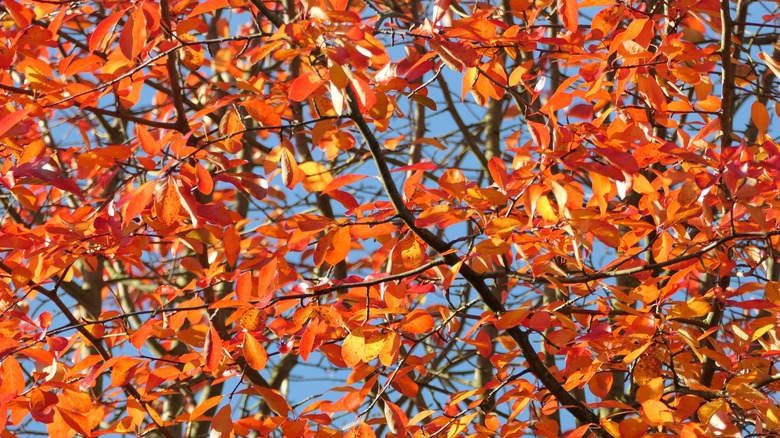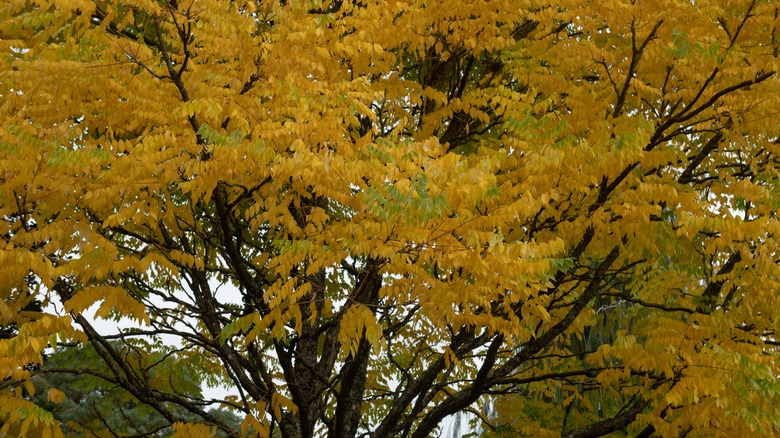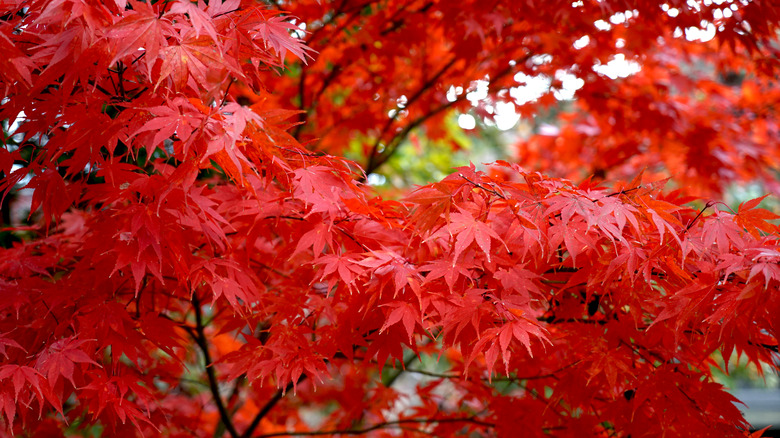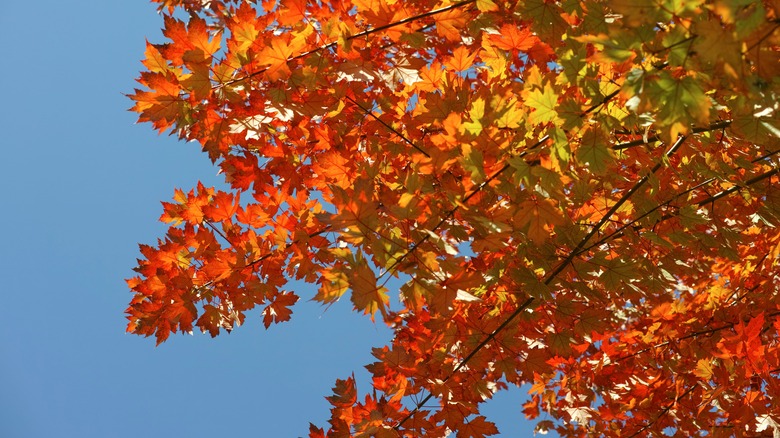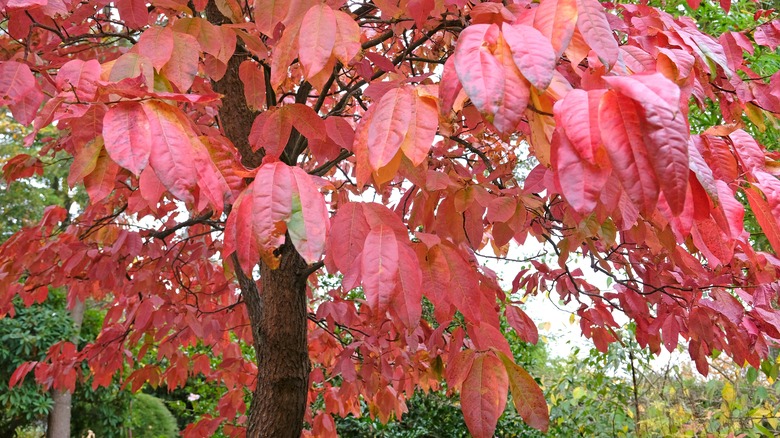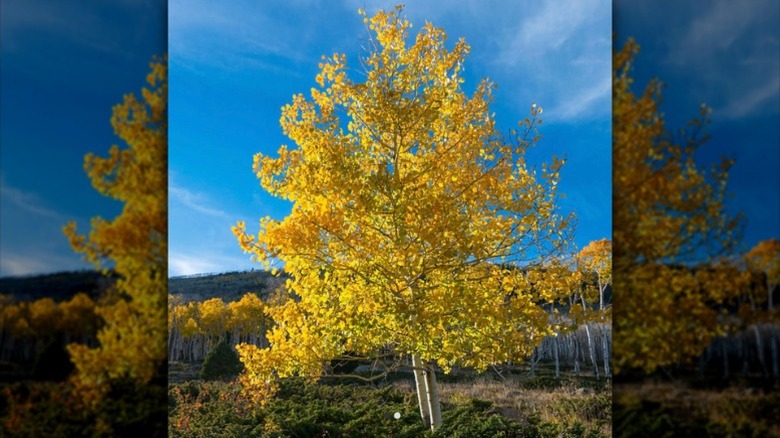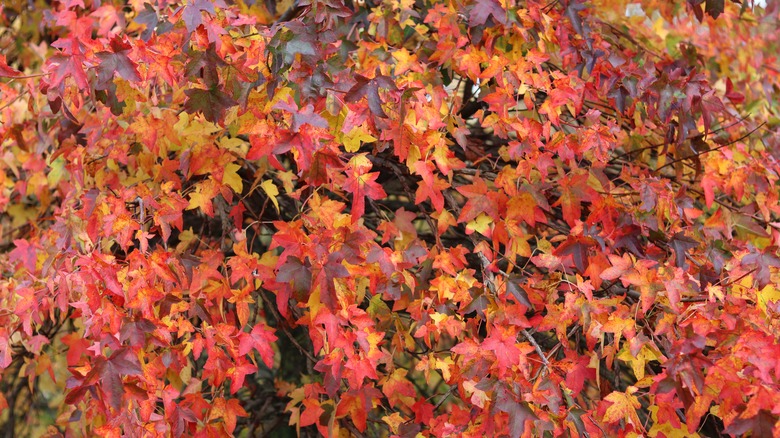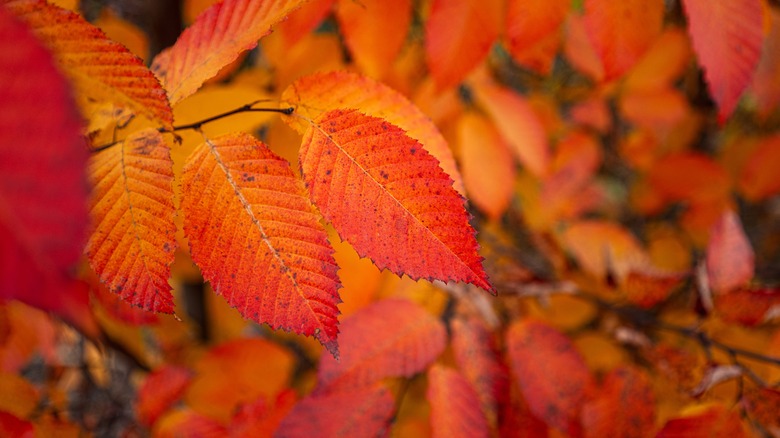10 Best Tree Varieties To Have In Your Yard For Fall
If you close your eyes on a fall day, you might hear a light breeze rustle through fallen leaves on the ground. The smell of pumpkin spice seems to float magically through the neighborhood and you're glad for a cozy sweater on a cool day. You inhale the crisp air as your hands hold onto a warm cup of apple cider. These shorter days might bring about more darkness but when you open your eyes you see an incredible array of scarlet red, golden yellow, and fiery orange displayed on the trees. If you want a front row seat to this autumn nature show every year, we found just the trees you need for your yard.
Deciduous trees like the maple and oak are ones that lose their leaves every year and, in the process, show off the typical red, orange, and yellow shades we love during the fall season. But did you know those fall colors are actually there the whole time? They're just covered up by a green pigment called chlorophyll. When the days get shorter and temperatures drop, the trees prepare for winter by producing less and less chlorophyll until the green pigment is gone. And thus, the leaves have "turned" their autumn shade.
Having deciduous trees in your yard does more than just put on a great seasonal light show. Their fallen leaves decompose and become organic matter that improves the quality of the soil, giving other plants in the surrounding yard a boost. You can leave those leaves (see what we did there?) right where they fall or you can add them to your compost, use them as mulch in your garden, or spread them across your lawn for further reach.
Black tupelo tree
The black tupelo tree (Nyssa sylvatica), also known as the black gum or common tupelo tree, is dynamic both in its height and dramatic fall colors. It can grow up to 75 feet high and shows off scarlet reds and deep purples throughout the autumn season. It is hardy in USDA zones 4 to 9 and prefers full sun to partial shade. Its height makes it a great street tree which offers a lot of shade in the warmer months. They also attract good pollinators, like bees.
Kentucky coffeetree
The Kentucky coffeetree (Gymnocladus dioicus) isn't going to make all your coffee dreams come true. Its seeds grow in pods and were used by early settlers as a coffee substitute (we wouldn't recommend it). Despite its name, there's no relation to actual coffee shrubs, as it's in the legume family. This beautiful tree will amaze you with its incredible height (growing up to 75 feet tall), its bright yellow leaves in fall, and interesting bark revealed in winter. It is hardy in USDA zones 3 to 8 and prefers full sun.
Sugar maple tree
The sugar maple (Acer saccharum) is first on our list of 10 stunning maple trees that will add drama to your yard, in part because of its stunning yellow, orange, and red leaves in the fall. Not only can these beauties grow up to 80 feet tall, they can also live for up to 400 years. As the name suggests, their sweet sap makes a delicious syrup (though you'll have to wait, as it can't be tapped for sap until it's 40 years old). They are hardy in USDA zones 3 to 8 and can grow in full shade.
Red maple tree
If you're looking for a gorgeous shade tree, search no further than the red maple (Acer rubrum) tree. It grows up to 70 feet tall and has a rounded crown with branches that can span 30 to 50 feet across. The leaves turn a beautiful, vibrant red in the fall and have little, red flower clusters in winter. The red maple tree is hardy in USDA zones 4 to 9 and grows well in partial to full sun. This is also a great choice for anyone looking for an easy tree that establishes and grows quickly.
Freeman maple tree
The freeman maple (Acer x freemanii) is a hybrid of red and silver maple trees and is one that allows you to quickly capture fall colors in your yard because of how fast it grows. Their leaves show off an array of bright orange, yellow, and reds throughout the autumn season. They can grow up to 70 feet tall and have a less invasive root system than others, making them a yard-friendly option. Freeman maples are hardy in USDA zones 3 to 6 and enjoy partial shade.
Sourwood tree
If you're looking for a tree that won't tower over the rest of your landscape like a downtown high-rise condominium, the sourwood tree (Oxydendrum arboreum) might be a good choice. It's more of a medium tree since it grows up to 30 feet tall. What it lacks in height it more than makes up for in its gorgeous fall colors of maroon, pink, and red. Sourwood trees also have very interesting bark in a red-brown shade with deep, furrowed lines. It is hardy in USDA zones 5 to 9 and prefers full sun or partial shade.
Quaking aspen tree
The quaking aspen (Populus tremuloides) got its name because their flat stems and broad leaves give the appearance of shaking when the wind blows. A fun and beautiful addition to any yard, the fast growing quaking aspen reaches heights of up to 50 feet tall. The attractive, white bark and vibrant, golden leaves in fall give off quite the seasonal show. The bright leaves contrast the white bark and give what looks like a twinkling light when the fall breeze blows through. It is hardy in USDA zones 1 to 6 and prefers full sun.
Sweet gum tree
The sweet gum tree (Liquidambar styraciflua) is also known as a redgum tree. If you're looking for a good shade tree, this is an excellent choice. The star-shaped foliage of a sweet gum tree turns a gorgeous red in the fall, making it an incredibly pleasing aesthetic that is also surprisingly long lasting. Interestingly, the tree has a sweet scented gum that seeps out of the wounded bark which has been used to make things like chewing gum, perfumes, and soap. The sweet gum tree is hardy in USDA zones 5 to 9 and prefers full sun.
Scarlet oak tree
Of all the types of oak trees you can plant in your yard, the scarlet oak (Quercus coccinea) is a beautiful choice for its colorful fall foliage. As you might expect, the leaves turn a scarlet red shade in the fall season. It grows up to 80 feet tall with a canopy that can spread up to 60 feet across. The scarlet oak is easy to grow but difficult to transplant, so choose a spot you'll want to keep for the long haul. It is hardy in USDA zones 4 to 9 and prefers full sun to partial shade.
American hornbeam tree
The American hornbeam tree (Carpinus caroliniana), also known as the blue beech or ironwood, offers a wide variety of fall colors; from yellow to orange and red to purple. It's the quintessential fall rainbow of colors. They are a medium size, growing up to 30 feet tall, and do well in partial sun to shade. You might also hear them referred to as musclewood trees because their bark resembles a muscular arm. The American hornbeam tree is super adaptable, withstanding mild flooding and tolerating slight drought. It is hardy in USDA zones 3 to 9.

